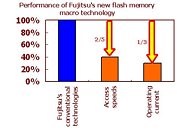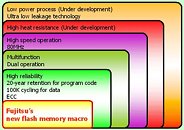Thursday, March 25th 2010

Fujitsu Develops New NOR Flash Memory Macro
Fujitsu Microelectronics Limited today announced the development of new flash memory macro that enables NOR flash memory circuits to achieve high-speed read operations while operating at low power currents. The new flash memory macro is guaranteed to retain program data storage for 20 years, or 100,000 write/erase cycles for data storage, while improving access speeds by 2.5 times to 10 nanoseconds (10 ns), and reducing the required operating current per cell by two-thirds to 9 microamperes (9 µA), compared to Fujitsu's past technologies. This technology will be implemented in microcontrollers featuring embedded flash memory in automotive, industrial, and consumer electronics applications for which high speed, low current, and high reliability are all priorities, thus contributing to a reduction in the burden on the environment.Background
Fujitsu has an established track record producing high-reliability microcontrollers featuring embedded NOR flash memory. However, with rising demand for microcontrollers that achieve even higher speeds while consuming less power, it becomes imperative to develop a new flash memory macro to accommodate these needs. Burst mode is one method of accelerating operation speeds of flash memory macros, but depending on characteristics of the CPU core, this can result in undesirable wait states while data is being processed, thereby lowering the overall performance of the microcontroller.
Overview of the new flash memory macro
The new flash memory macro uses circuit elements from Fujitsu's proprietary high-speed memory-access technology FCRAM (fast-cycle random-access memory) in its NOR flash memory circuit, resulting in high speed, low operating current, and high reliability.
By utilizing - as a key feature of FCRAM - an optimized cell array that reduces load during drive operation, and through innovations in power-supply management technology, the new flash memory macro can accelerate data-read methods. These innovations improve access speeds by 2.5 times to 10 ns, while cutting operating current for each cell by two-thirds to 9 µA, compared to Fujitsu's past technologies (Figure 1, above). By utilizing microcontrollers embedded with this technology, it becomes possible to enhance the performance of battery-operated portable audio-visual devices and to extend battery life.
Future Developments
The new flash memory macro will be used as a core technology for ecological technologies (Figure 2). By offering flash memory microcontrollers embedded with these ecological technologies, Fujitsu will be able to provide high reliability, high temperature tolerance and high-speed technologies that are particularly essential for automotive applications. The inclusion of these environmentally-friendly technologies in microcontrollers with embedded flash memory will contribute to a reduction in the environmental burden footprints of embedded systems.
Fujitsu has an established track record producing high-reliability microcontrollers featuring embedded NOR flash memory. However, with rising demand for microcontrollers that achieve even higher speeds while consuming less power, it becomes imperative to develop a new flash memory macro to accommodate these needs. Burst mode is one method of accelerating operation speeds of flash memory macros, but depending on characteristics of the CPU core, this can result in undesirable wait states while data is being processed, thereby lowering the overall performance of the microcontroller.
Overview of the new flash memory macro
The new flash memory macro uses circuit elements from Fujitsu's proprietary high-speed memory-access technology FCRAM (fast-cycle random-access memory) in its NOR flash memory circuit, resulting in high speed, low operating current, and high reliability.
By utilizing - as a key feature of FCRAM - an optimized cell array that reduces load during drive operation, and through innovations in power-supply management technology, the new flash memory macro can accelerate data-read methods. These innovations improve access speeds by 2.5 times to 10 ns, while cutting operating current for each cell by two-thirds to 9 µA, compared to Fujitsu's past technologies (Figure 1, above). By utilizing microcontrollers embedded with this technology, it becomes possible to enhance the performance of battery-operated portable audio-visual devices and to extend battery life.
Future Developments
The new flash memory macro will be used as a core technology for ecological technologies (Figure 2). By offering flash memory microcontrollers embedded with these ecological technologies, Fujitsu will be able to provide high reliability, high temperature tolerance and high-speed technologies that are particularly essential for automotive applications. The inclusion of these environmentally-friendly technologies in microcontrollers with embedded flash memory will contribute to a reduction in the environmental burden footprints of embedded systems.


3 Comments on Fujitsu Develops New NOR Flash Memory Macro
1. Does this device work at 33% of the operating current. Yes. But is it 33% of the power consumption? Dont know! Power consumption also depends on VOLTS!!??
2. And does access time really go down, or is that just 40% of the original performance? Which, BTW, might be OK for an embedded device, where power efficiency and longevity is more important than overall speed.
My goodness, what a horrible chart.